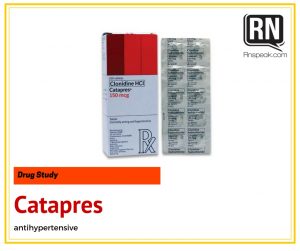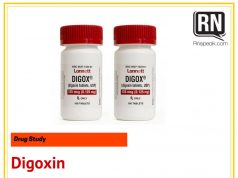Generic Name: Clonidine Hydrochloride
Brand Name: Catapres, Catapres-TTS, Dixaril , Duraclon
Classifications: cardiovascular agent; central-acting antihypertensive; analgesic
Pregnancy Category:C
Availability 0.1 mg, 0.2 mg, 0.3 mg tablets; 0.1 mg/24 h, 0.2 mg/24 h; 0.3 mg/24 h transdermal patch; 100 mcg/mL, 500 mcg/mL injection
Actions
Centrally acting antiadrenergic derivative. Stimulates alpha2-adrenergic receptors in CNS to inhibit sympathetic vasomotor centers. Central actions reduce plasma concentrations of norepinephrine. It decreases systolic and diastolic BP and heart rate. Orthostatic effects tend to be mild and occur infrequently. Also inhibits renin release from kidneys.
Therapeutic effects
Decreases systolic and diastolic BP and heart rate. Orthostatic effects tend to be mild and occur infrequently. Reportedly minimizes or eliminates many of the common clinical S&S associated with withdrawal of heroin, methadone, or other opiates.
Uses
Step 2 drug in stepped-care approach to treatment of hypertension, either alone or with diuretic or other antihypertensive agents. Epidural administration as adjunct therapy for severe pain.
Contraindications
Pregnancy (category C), lactation. Use of clonidine patch in polyarteritis nodosa, scleroderma, SLE.
Cautious use
Severe coronary insufficiency, recent MI, sinus node dysfunction, cerebrovascular disease; chronic renal failure; Raynaud’s disease, thromboangiitis obliterans; history of mental depression.
Route and Dosage
Hypertension
adult: PO 0.1 mg b.i.d. or t.i.d., may increase by 0.1–0.2 mg/d until desired response is achieved (max 2.4 mg/d)
Transdermal 0.1 mg patch once q7d, may increase by 0.1 mg q1–2wk
geriatric: PO Start with 0.1 mg once daily
child: PO 5–10 mcg/kg/d divided q8–12h, may increase to 5–25 mcg/kg/d divided q6h (max 0.9 mg/d)
Severe Pain
adult: Epidural; start infusion at 30 mcg/h and titrate to response. Use rates >40 mcg/h with caution
child: Epidural ; start infusion at 0.5 mcg/kg/h and titrate to response
ADDH
child: PO 5 mcg/kg/d in 4 divided doses (average dose, 0.15–0.2 mg/d).
Transdermal 0.2–0.3 mg/d q5–7d
Adverse Effects
CV: Hypotension (epidural), postural hypotension (mild), peripheral edema, ECG changes, tachycardia, bradycardia, flushing, rapid increase in BP with abrupt withdrawal.
GI: Dry mouth, constipation, abdominal pain, pseudo-obstruction of large bowel, altered taste, nausea, vomiting, hepatitis, hyperbilirubinemia, weight gain (sodium retention).
CNS: Drowsiness, sedation, dizziness, headache, fatigue, weakness, sluggishness, dyspnea, vivid dreams, nightmares, insomnia, behavior changes, agitation, hallucination, nervousness, restlessness, anxiety, mental depression.
Skin: Rash, pruritus, thinning of hair, exacerbation of psoriasis; with transdermal patch: hyperpigmentation, recurrent herpes simplex, skin irritation, contact dermatitis, mild erythema.
SpecSenses: Dry eyes.
Urogenital: Impotence, loss of libido.
Nursing Implication
Assessment & Drug Effects
- Monitor BR closely. Determine positional changes (supine, sitting, standing).
With epidural administration, frequently monitor BP and HR. - Hypotension is a common side effect that may require intervention.
- Monitor BP closely whenever a drug is added to or withdrawn from therapeutic regimen.
- Monitor I&O during period of dosage adjustment. Report change in I&O ratio or change in voiding pattern.
- Determine weight daily. Patients not receiving a concomitant diuretic agent may gain weight, particularly during first 3 or 4 d of therapy, because of marked sodium and water retention.
- Supervise closely patients with history of mental depression, as they may be subject to further depressive episodes.
Patient & Family Education
- Although postural hypotension occurs infrequently, make position changes slowly, and in stages, particularly from recumbent to upright position, and dangle and move legs a few minutes before standing. Lie down immediately if faintness or dizziness occurs.
- Avoid potentially hazardous activities until reaction to drug has been determined due to possible sedative effects.
- Do not omit doses or stop the drug without consulting the physician.
- Do not take OTC medications, alcohol, or other CNS depressants without prior discussion with physician.
Examine site when transdermal patch is removed and report to physician if erythema, rash, irritation, or hyperpigmentation occurs. - If transdermal patch loosens, tape it in place with adhesive. The patch should never be cut or trimmed.
- Do not breast feed while taking this drug.









Thank you so much. its very useful for us student nurses